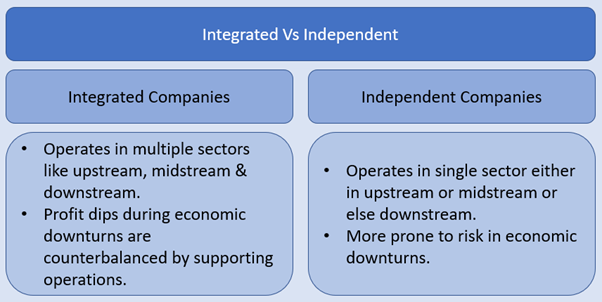Integrated oil & gas companies are the ones that operate over the whole oil value chain system from oil exploration and production to shipment via tankers or pipelines and finally refining, and marketing of petroleum products. Overall operations of integrated companies are categorized into three main classes that are:
Upstream Operations: This operation involves all the activities which are related to search, explore and produce the subsurface deposits of hydrocarbons;
Midstream Operations: This operation involves all the activities which are involved in the primary processing and transportation of produced hydrocarbon via tankers and pipelines to the refineries for further processing.
Downstream Operations: This operation deals with all the activities involved in the refining, fractionation and marketing of petrochemical products.

Kalkine Group Image
Understanding Integrated Approach:
The foundation of integrated O&G company was started in the 1890s with the Standard Oil Trust. Standard Oil was broken into smaller independent companies in 1911 as per the Sherman Antitrust Act 1890, which prohibits the restraint of trade. Although the defenders of the company believed that the company didn't restrain the trade instead were giving a superior level of competition. The "baby Standards" that still exist are ExxonMobil and Chevron and are having operations worldwide in an integrated manner.
The integrated companies are often known as Oil majors, big oil, integrated majors and super majors. As per their roles from the upstream sector to the downstream industry, these companies have large assets related to exploration, production, transportation, refining, marketing and retailing of the petroleum products.
Integrated Vs Independent:
An independent oil and gas organization is one that operates around just one fragment of the oil and gas industry. There are both merits and demerits of being either an independent or integrated company. Integrated companies have vertical integration, they have multiple verticals operating in different sectors like upstream, midstream and downstream. Being in touch with all verticals, an integrated oil and gas organization is in direct contact with the energy and market insights. This helps an integrated company to manage its E&P activities as per the demand of petroleum products in the market. Market evaluation of an integrated oil and gas organization can be difficult because of their lumped operation and production assets which leads to a lower market evaluation.
An independent oil and gas organization with just one sort of business activity carries a more honed centre to its business movement. However, the limitation of switching operating sectors as per the prevailing market demand to stabilize the profits in horrible economic situations is an opportunity that is not present with independent companies.

Kalkine Group Image
How big are Super Majors?
Global petroleum industry has various types of O&G companies in its fold. The ones who operate in one sub-industry, the others are oil majors and then comes the actual super majors National Oil companies who are accountable for every molecule of hydrocarbon that has been explored and consumed. It isn't easy to evaluate the market cap of an integrated company and map it on the global O&G market, as they have businesses in diverse field. To understand the massiveness of an integrated company one can, visualize that the ten largest oil super majors listed on the U.S. stock exchanges hold around one-fifth of the world's O&G production and nearly a quarter of global refining size.
Oil price effect on Integrated & Independent Companies:
An independent oil and gas organization may flourish or shrink on the rise or fall of oil and gas costs. In contrast, an integrated oil and gas organization frequently has less impact on price fluctuations. Dips in profits can be hedged and counterbalanced by its supporting operations either by upstream or downstream businesses.
For example, if the oil prices go down in the international market, the profit margin earned by E&P companies goes down but being and integrated company, it can stock more amount of crude oil at lower prices and can lock more raw material for its downstream operation ensuring higher profit margin and counterbalancing the losses incurred in exploration & production.
 Please wait processing your request...
Please wait processing your request...